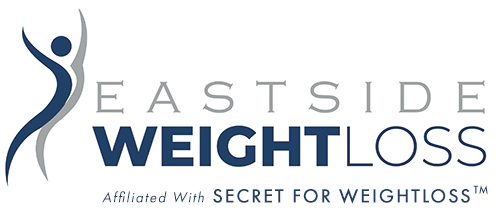Eastside Weight Loss
Different Types of Fat and Their Role in Weight Management

If you’ve ever tried to lose weight, you’ve probably heard the phrase ‘fat makes you fat’. But that’s an oversimplification. Your body actually needs fat to survive.
The important thing is to understand the types of body fat and the different kinds of dietary fat you eat.
Some fats help with energy, hormone regulation, and vitamin absorption. Others can work against your health and sabotage your weight management goals. The more you know about the fat types in the body and the best fats for weight loss, the easier it is to make informed choices about your long-term health.
Let’s break it all down.
Types of Fat
Not all body fat is the same. Each type serves a purpose, and knowing the distinction can help you better manage your health:
Essential Body Fat: This is the fat your body needs to function. It supports hormone regulation, organ protection, and cell health. For men, a healthy body fat percentage typically ranges from 6–24%. For women, it’s about 16–30%. Anything lower than the “essential” range can be dangerous.
Storage Body Fat: This is the extra fat your body keeps in reserve. Some is necessary for insulation and energy, but too much increases the risk of heart disease, diabetes, and other conditions.
Visceral Fat: A type of storage body fat that surrounds your organs, this is the most dangerous form since it’s linked to high blood pressure, insulin resistance, and inflammation.
Subcutaneous Fat: This refers to the fat just under your skin. While less harmful than visceral fat, carrying too much of it can still affect your health and make weight loss harder.
Understanding these fat types in the body is the first step in making better food and lifestyle decisions.
Unsaturated Fats: A Friend for Your Heart and Waistline
When people talk about healthy fats for weight loss, they’re usually referring to unsaturated fats.
Unsaturated fats are good for you. Health experts recommend that adults get between 20 and 35% of their daily calories from fat, preferably the unsaturated kind.
Unsaturated fats help lower “bad” LDL cholesterol while raising “good” HDL cholesterol, which supports a stronger heart. They also make it easier for your body to absorb fat-soluble vitamins like A, D, E, and K. On top of that, they help reduce inflammation and keep you feeling full for longer periods of time, which naturally helps with portion control and weight balance.
You’ll find monounsaturated fats in foods such as olive oil, avocados, and nuts. Polyunsaturated fats, including the beneficial omega-3s, are abundant in salmon, sardines, flaxseed, and walnuts. Research shows that replacing saturated fats with these unsaturated options can lower the risk of heart disease and support long-term weight management.
Trans Fats: A Foe in the Weight Loss Journey
If there’s one fat you should avoid altogether, it’s trans fat. Found in processed foods like doughnuts, fried fast food, margarine, and frozen pizzas, trans fats:
- Increase bad cholesterol (LDL)
- Lower good cholesterol (HDL)
- Increase inflammation and insulin resistance
- Raise your risk of obesity and heart disease
Even small amounts are harmful. In fact, the American Heart Association estimates that cutting trans fats from the food supply could prevent thousands of heart-related deaths each year. If you want to focus on the best fats for weight loss, cutting trans fats is the first step.
Saturated Fats: The Jury Is Still Out
Saturated fats have been debated for years. Older guidelines warned against them entirely, but newer research shows the picture is more complicated.
- Replacing saturated fats with refined carbs doesn’t improve health.
- Replacing them with unsaturated fats, however, lowers disease risk and supports better weight outcomes.
Sources of saturated fat include red meat, butter, cheese, and coconut oil. Instead of cutting them out completely, it’s better to enjoy them in moderation while prioritizing healthy fats for weight loss like olive oil, nuts, and fish.
Omega Fatty Acids: Balancing the Scale
Omega-3 and omega-6 fatty acids are a unique type of polyunsaturated fat. Since the body cannot produce them on its own, they need to come directly from the foods you eat.
Omega-3s, found in sources like fatty fish, flaxseeds, and chia seeds, are especially valuable because they reduce inflammation and lower the risk of obesity.
Omega-6s, on the other hand, are present in vegetable oils and many processed foods. While they are necessary in small amounts, consuming too much of them can encourage fat storage and disrupt the body’s natural balance.
The real challenge lies in proportion. Most people today eat far more omega-6 than omega-3, and this imbalance can interfere with metabolism and make weight regulation more difficult. Research shows that increasing omega-3 intake can improve body composition and strengthen your efforts toward better weight management.
Dietary Cholesterol and Obesity Risks
Dietary cholesterol used to be blamed for heart disease, but now experts say it’s not as dangerous as once believed. The bigger concern is how excess storage body fat contributes to health risks like high blood pressure, diabetes, and stroke.
Studies note that losing just 5–10% of your body weight can reduce these risks significantly. For someone weighing 200 pounds, that’s a loss of just 10–20 pounds, enough to improve cholesterol levels, lower blood sugar, and decrease heart strain.
Putting it All Together
Not all fats are bad, and some are essential for good health. The trick is knowing the difference between essential body fat that keeps you alive, storage body fat that can get out of hand, and the dietary fats that either help or harm your progress. By choosing the best fats for weight loss and balancing your fat intake, you set yourself up for sustainable health and long-term weight management.
If you’re ready to take the next step, Eastside Weight Loss Clinic can help you reset your metabolism, shed excess fat, and build habits that last. Schedule a free phone consultation today to talk with a real coach, get a personalized plan, and see how you could lose 10–20% of your body weight in as little as 60 days.

